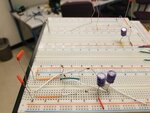LouieM
Newbie level 3
Hello I am an undergrad student and was given the task of designing a rectenna in ADS with very little knowledge of how to use ADS or microwave design so and guidance in this would be so helpful. I guess my main issue is that I have built the rectifier that I designed in ADS and my results do not match at all. Also I performed a power sweep on the circuit and an it seems like the dBm out exponentially increases as pin increases. I read online that there will be a saturation point then decay. Can you see anywhere in my circuit that is wrong that may be causing this issue.
Thank You
Lou
Thank You
Lou



